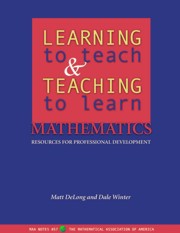Book contents
- Frontmatter
- Preface
- Contents
- 1 The Professional Development Program
- 2 How to Use this Book
- 3 An Orientation Session for the Beginning of the Semester
- 4 Making In-class Groups Work
- 5 Getting Students to Read the Textbook
- 6 Assessing and Evaluating Students' Work
- 7 Managing Homework Teams
- 8 Teaching During Office Hours
- 9 Establishing and Maintaining Control in Your Classroom
- 10 Proctoring Tests and Examinations
- 11 Teaching with Calculators and Computers
- 12 Making Lesson Plans
- 13 Strategies for Motivating Students
- 14 Dealing With Difficult Instructor-Student Situations
- 15 End-of-Semester Administration
- 16 Adapting Materials and Designing Your Own Meetings
- 17 Classroom Visits
- A Tips for Running Meetings
- B The Michigan Introductory Program
- Bibliography
4 - Making In-class Groups Work
- Frontmatter
- Preface
- Contents
- 1 The Professional Development Program
- 2 How to Use this Book
- 3 An Orientation Session for the Beginning of the Semester
- 4 Making In-class Groups Work
- 5 Getting Students to Read the Textbook
- 6 Assessing and Evaluating Students' Work
- 7 Managing Homework Teams
- 8 Teaching During Office Hours
- 9 Establishing and Maintaining Control in Your Classroom
- 10 Proctoring Tests and Examinations
- 11 Teaching with Calculators and Computers
- 12 Making Lesson Plans
- 13 Strategies for Motivating Students
- 14 Dealing With Difficult Instructor-Student Situations
- 15 End-of-Semester Administration
- 16 Adapting Materials and Designing Your Own Meetings
- 17 Classroom Visits
- A Tips for Running Meetings
- B The Michigan Introductory Program
- Bibliography
Summary
Since the Tulane conference [42], substantial amounts of time and resources have been put towards developing materials for non-lecturing, student-centered classroom techniques. Some techniques that are used by many instructors are cooperative learning activities, student presentations, laboratory activities, discovery learning, and the Moore method. In our classrooms we extensively use the technique of having students work in cooperative groups on mathematical problems. In this chapter we focus on developing the instructors' facility with implementing and managing in-class cooperative activities. If your program includes student- centered teaching methodologies not addressed by one of the meetings in this book, Chapter 16 provides support for developing new training meetings.
Cooperative learning is a popular pedagogical device in elementary collegiate mathematics classrooms. There are many reports that suggest that when cooperative learning is implemented effectively in a mathematics class, there can be dramatic gains in what students are able to accomplish in terms of solving non-routine problems, in students' appreciation of and enjoyment in mathematics, and in students' willing- ness to persist in their attempts to solve and develop meaningful understanding of mathematical concepts that go beyond simple imitation of “worked examples” from the textbook. Although some investigators have reported some gains in terms of students' scores on standardized tests, the reports are not usually of dramatic gains [35]. A typical report is of the form “The students in the cooperative learning group performed at least as well as students in a control group.”
Information
- Type
- Chapter
- Information
- Learning to Teach and Teaching to Learn MathematicsResources for Professional Development, pp. 43 - 54Publisher: Mathematical Association of AmericaPrint publication year: 2002
